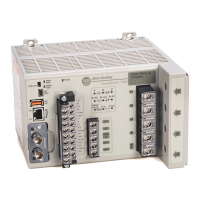Rockwell Automation Publication 1426-UM001J-EN-P - August 2019 73
Metering Chapter 4
Nominal_System_LL_Voltage
Nominal_System_Frequency
These parameters specify the nominal system (line-to-line) voltage and
frequency. The power monitor uses these values to optimize metering accuracy,
and the M6 and M8 models use these values to set thresholds for detection of
power quality events.
Realtime_Update_Rate
This parameter specifies the averaging used and the update rate of metering
results to the data tables and setpoint calculations. You can select from the
following:
0 = Single cycle averaged over 8 cycles
1 = Single cycle averaged over 4 cycles
2 = 1 cycle with no averaging
Related Functions
• Voltage and Current Metering
•Power Metering
• Energy Metering
•Demand Metering
• Configuration Lock
•Data Logging
• Power Quality monitoring
Wiring Diagnostics
The PowerMonitor 5000 unit provides a means for you to verify proper power
monitor connections and diagnose wiring errors. To meter power and energy
correctly, voltage and current inputs must be connected to the power circuit with
the correct phase rotation and polarity. Indications of wiring errors include the
following:
• Indication of negative real power (kW) on a load, or indication of positive
power on a generator
• Power factor outside the range of 45% lagging to 80% leading
• Very different power and/or power factor values on different phases
Wiring diagnostics operate on command in any wiring mode, and require a level
of measured current at least 5% of the nominal metering scale, or 250 mA of CT
secondary current. For example, a power monitor with 600:5 CT ratios that are
configured for I1, I2, and I3 requires 30 amps of load current for wiring
diagnostics to operate.

